Help and Support
This article explains what cookies are and how to enable/disable them for your web browser.
- What are cookies?
- Managing cookies in Internet Explorer 7
- Managing cookies in Safari
- Managing cookies in Firefox
1. What are cookies?
A cookie is a piece of information that is stored on your PC in order for information from websites to be stored. These are saved as small text files that are kept in a cookies folder on your hard drive. Cookies themselves are not harmful and cannot contain viruses or spy on the contents of your hard drive.
These text files normally contain the following information:
- The web server the cookie originates from
- The lifespan of the cookie (this can be permanent or expire after a specific amount of time or when the browser is closed)
- A unique reference, which allows the cookie to be recognized by the web server
Cookies are used for various purposes, from authenticating users to maintaining specific information, for instance when using online shops.
Some sites require cookies to be turned on in order to function correctly, typically if using online banking or online shopping.
Back to Top
2. Managing cookies in Internet Explorer 7
Click the Tools menu and select Internet Options:
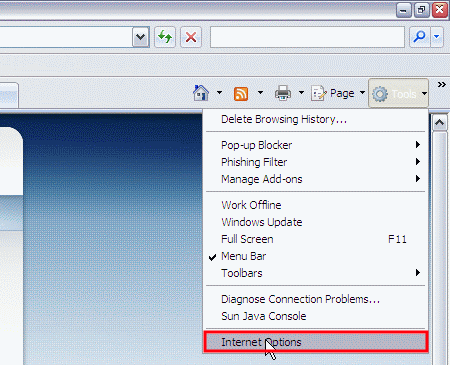
Click the Privacy tab:
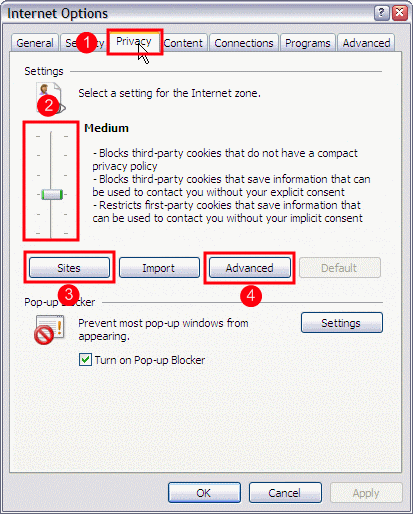
- Click the Privacy tab.
- Select the level of protection you wish to use, the default setting of Medium is ideal for most users.
- If you want to edit settings for individual sites, click the Sites button. (More information provided below)
- If you want to edit the advanced settings, click the Advanced button. (More information provided below)
The settings range from blocking all cookies to allowing all cookies. The default setting on this is medium. We recommend leaving your setting at medium.
Click the Sites button to allow you to specify settings for individual sites:
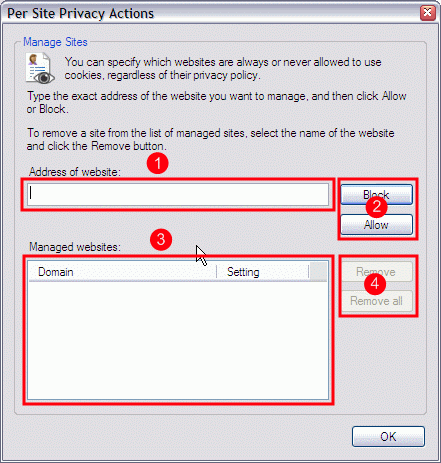
- Add the address of a site you wish to add individually.
- Choose if you are wishing to allow or block the site.
- A list of your individually specified websites and their settings will be shown here.
- You can select individual sites and remove them or remove all the individual settings as required.
To see more settings click the Advanced button:
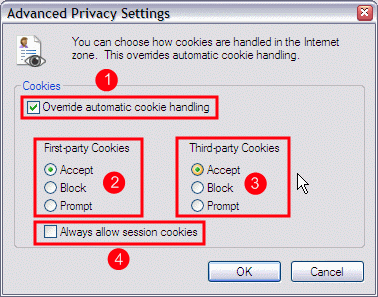
- Choose whether you wish to override Internet Explorer 7's own handling of cookies.
- Choose how you wish to deal with first-party cookies. These are cookies which are being sent from the website you are viewing.
- Choose how you wish to deal with third-party cookies. These are cookies sent from a site other than the one you are looking at. For instance, if a company runs several websites, they may have a central server which looks after cookie requests or allows you to retain preferences between multiple websites.
- Choose whether you wish to allow session cookies. These are typically used to store information such as your location or colour preferences you may have selected.
3. Managing cookies in Safari
Click the Safari menu and select Preferences:
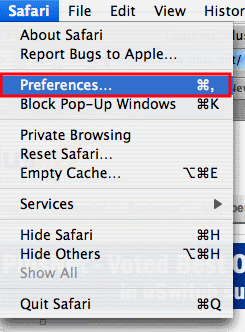
Click on the Security tab:
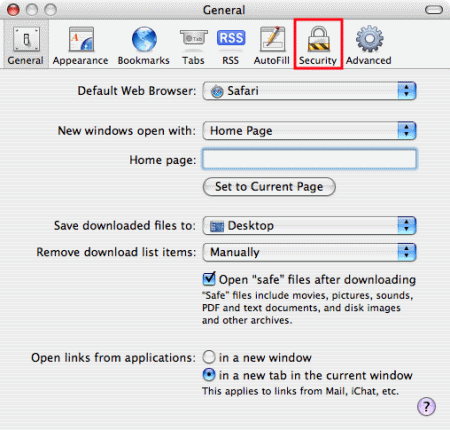
In the Security tab you can control how Safari deals with cookies:
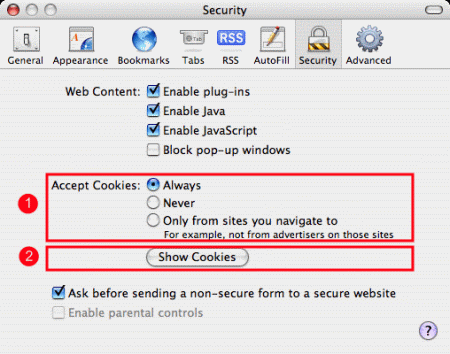
- Choose whether you wish to accept all cookies, no cookies or just those relating directly to the site you would be viewing.
- If you wish to see more information on currently stored cookies click this option. (See diagram below)
The Show Cookies button will show you information about those cookies already in place on your computer:

- Select an individual cookie if you wish to delete it.
- Click Remove if you have highlighted a single cookie.
- Click Remove All to remove all cookies stored.
- Click Done once you have finished with this screen.
If you choose never to accept cookies and then find that you need one in order for a site to correctly work, you will need to allow the cookies, by selecting allow. Once you have finished with the page, you will need to change the settings back to never and remember to delete the cookies that have been stored.
Back to Top
4. Managing cookies in Firefox
Click Tools and select Options:

Select the Privacy tab:
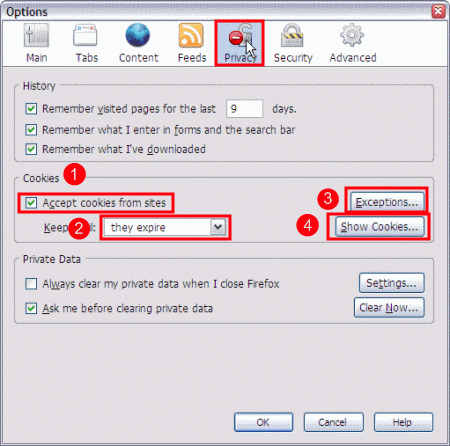
- Tick this option to allow cookies by default.
- Choose how long a cookie remains valid.
- If you wish to specify exceptions to the general setting you selected in option 1, click here to make changes.
- Click the Show Cookies button to see the cookies stored in your browser. See the next screenshot for more information.
In here you can choose to manage how the browser handles cookies. By selecting the 'keep until' option, you can set cookies to be allowed until they expire, until Firefox is closed or request Firefox asks before accepting cookies
When a cookie notification is raised, there is an option to always allow cookies for this site. This is useful for sites that you trust, i.e. our web portal or eBay etc.
You can see a list of cookies that have been accepted by selecting the Show Cookies option. If there is a cookie in here that is not required this can be removed individually or all cookies can be removed.
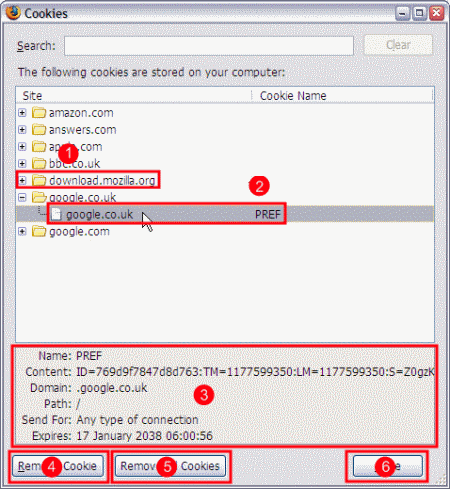
- Click on a site to see the cookies stored for it.
- Here is a preference cookie stored from google.co.uk.
- This section shows the content of the cookie and the expiration date.
- You can select Remove Cookie to remove a single cookie.
- You can select Remove All Cookies to remove all stored cookies.
- Click the Done button once finished.
Having problems with your broadband connection?
Report a problem with your service. It's faster by text.
Service Status
For full details of our current issues or any maintenance work that could be affecting your service please visit our Service Status site.
Can't find what you're looking for?
If we've not been able to address your query through a support article please contact Customer support for further assistance.
